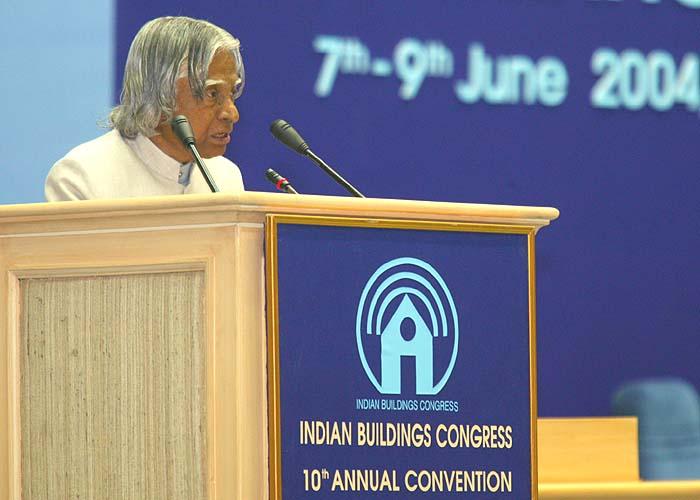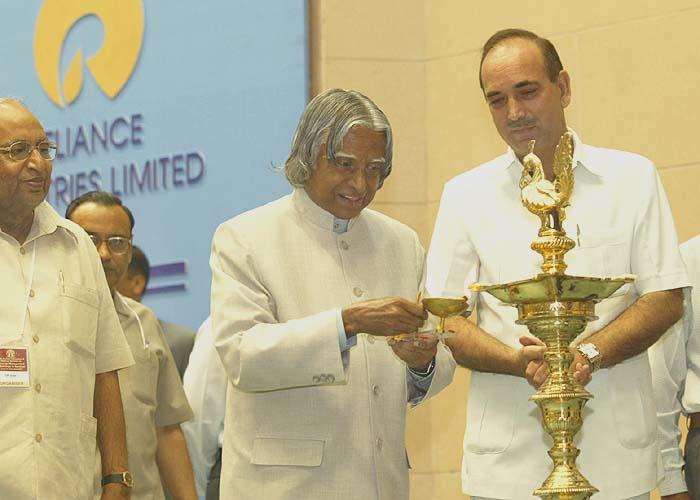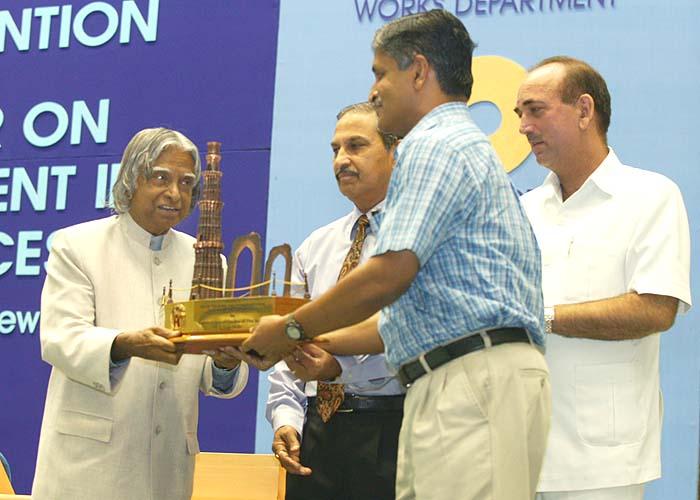Address at the Inauguration of 10th Annual Convention and National Seminar of Indian Buildings Congress on ?energy Management in Buildings & Services
New Delhi : 08-06-2004
Optimal Energy Mission for Building industry
I am delighted to participate in the inaugural function of the 10th Annual Convention and National Seminar of Indian Buildings Congress on ?Energy Management in Buildings and Services?. My greetings to the organizers, distinguished guests and all the participants of this seminar.
The experiences
When I am in the midst of energy management specialists, I would like to share with you two experiences. The first one is regarding use of solar energy for cost effective heating at Brahmakumaris Shantivan Complex, Abu and the second one is related to use of Nano technology for producing energy efficient and cost effective LEDs (Light Emitting Diodes).
Large Scale Solar Cooking
Solar cooking is one of the important application in the field of renewable energy. During the last 20 years many designs and concepts have been developed and tested in the field of family cooking in the form of box type solar cookers. Now Swiss technology has come to complement the box cookers. With the Swiss technology it is possible to cook for larger number of persons using solar energy within a short span of time. Prajapita Brahmakumaris Iswariya Vishwa Vidyalaya has become one of the institutions, who have manufactured in their own workshop at their premises and installed a large solar steam cooking system at their headquarters Shantivan Complex, Abu Road, Rajasthan. The system is designed for cooking 2000 meals twice daily based on the certain technological collaboration. Typical power generated is 1 Mega Watt hour per day.
I am citing this example to suggest to you the necessity for making such systems in all our big apartments, hotels and industrial complexes, which can substantially reduce the energy, cost and also minimize the pollution created by using other forms of energy sources.
High Efficiency Nano Crystal LEDs
Dr. R.N. Bhargava, a Nano technologists from USA came and met me at the Rashtrapati Bhavan. He demonstrated to me a very optimal and efficient lighting system based on Nano crystals. The recent advances in semi conductor based lighting chips ? Light Emitting Diodes (LED) can provide six hours of reliable light to every home or shop in a village at virtually no recurring energy cost and minimum installation cost. These LEDs require a tiny fraction of energy used for other forms of lighting. LED based lighting can be easily provided with solar panels or foot pedal generators. For nearly 40 years LEDs were weak color light sources (Green, Amber and Red) used mostly as indicators and numeric light. LED technology in recent years has improved dramatically. Today LEDs, using 10 watt of power could produce light equivalent to a sixty-watt filament lamp. Filament lamps are highly inefficient since 90% of the energy is dissipated as heat, Fluorescent lamps are more efficient but still waste energy by heating gases, whereas LEDs convert energy to light very efficiently. Typical LED lamps burn over 10 years or longer, they withstand much greater temperature changes, mechanical vibrations and shock. They are reliable and fade away slowly and there is no sudden stoppage of light. New discoveries in Nano technology make LEDs much brighter and make the products less expensive, which can revolutionize rural electrification for lighting. The field is fertile for research and development of high efficient and low cost LEDs, using Nano-Crystal.
Newer design perspectives
Let us now address energy conservation issues pertaining to buildings and related services. Energy is required while constructing the buildings and subsequently for their maintenance in the form of providing lighting, maintaining a desired particular temperature, provision of essential services such as water, drainage system, heating, cooking etc. The building design has to take into account both these aspects so that construction cost of the building can be low and also the recurring cost for getting the different services by the occupant is also low.
Energy consumption: Targets
It is reported that the total energy consumption in Indian Buildings as follows:
Commercial sector : 21.6 billion kwh (32% for A/C, 60% for lighting, 8% others)
Residencial sector : 36 billion kwh (35% light, 29 % fan, 7% cooler, 14% Refrigeration, 4% A/C, 11% others)
One of our expert says that ?For a normally constructed building, the present energy consumption is 300 kwh per m sq annually which can be brought down to 140 kwh per sq annually by proper design/details/philosophy, where as in Germany with its strict energy codes it is reported that the consumption is only 50 kwh per m sq annually. It is all the more important for India to achieve at least a target of 100 kwh per m sq annually with in the next 5 years. This will need coordinated effort between architects, builders and the energy engineers, a newly developed expertise.
I am sure this congress, will consider the generation of energy efficient building codes.
The architects and building planners have to play a very important role in the design of the building with these features. The seeds of this perspective have to be sown in the schools of architecture and town planning. Energy conservation should start right from the location of the site, the direction of buildings, windows, doors, glare etc., the aim should be to use maximum advantage of the sun and wind, while minimizing the wasteful heat load from sun into the buildings and roofs.
Embodied Energy
The construction sector plays a significant role in economic development of the country. Activities in the construction sector are complex, highly dispersed and resource demanding. The activities of the sector result in the loss of important natural assets and impose severe stress on the environment. Agricultural land is often lost through urbanization and extraction of raw materials. The consumption of fossil fuels contributes to increased air pollution and emissions of greenhouse gases. Energy is required for manufacturing materials, for transport and for construction of buildings. Apart from this initial energy use, there is also need for energy for functioning of buildings. In the developed countries there is a growing demand for an environmental impact assessment of all building projects, which includes considerations of embodied energy i.e. the energy that is consumed in extraction of raw materials and production of finished building materials.
However construction is crucial to the prosperity and civilization of human beings. People require habitats, schools, work places, markets, places for sports and cultural activities. Our task therefore is to have more and better construction for our billion people, but minimize percapita energy consumption in the whole chain of value addition in construction and maintenance for example, the comparative embodied energy consumed for different type of buildings is indicated below:
Type of Building ------ Embodied energy (KWH per sq.m)
(a) Residential Buildings ---- 2200
(b) Office Buildings ----------- 5000
(c) Hotels ---------------------- 4000
(d) Hospital Buildings --------- 5500
The energy use in the production of building materials accounts for a high proportion of the total embodied energy in buildings, and thus improvement of energy use in production processes is a crucial part of any overall strategy for energy conservation in the built environment.
Energy Conservation Building Codes
There are codes, by-laws, standards and building (development) control regulations for design of buildings. But these codes do not promote energy conscious building design. Other than codes for air conditioning, the only existing code is a guide to the heat insulation of non-industrial buildings. The National Building Code that has recently been revised, lays down a set of minimum design provisions to protect people with regard to architectural & structural efficiency, fire hazards and health aspects of buildings, including safety against earthquakes in Zone 4. However, there are no standards/guidelines for energy efficiency designs. Hence, there is an urgent need to develop Energy Conservation Codes in India. I understand that some organizations in India like CII have started a process of evolving Green Building norms. These practices have to be strengthened and multiplied rapidly.
With this in view, the existing by-laws of different cities in the country should be critically examined with respect to solar passive architecture considerations. The opinions and views of practicing architects, academicians and planners should be considered through questionnaires and discussion. The by-laws in their current form do not find reference to a number of solar passive features. So modifications to the building by-laws for incorporating solar passive aspects should be undertaken.
A combination of perspective and performance-based by-laws can be adopted for formulation of Building Energy Codes Prescriptive would mean regulating heights of building, widths and orientation of streets, etc. Performance would refer to the specification of individual building such as U-value of envelope, energy consumed per unit area, etc. In case of air-conditioned buildings, the upper limit for the energy consumption of an unoccupied building without any internal loads can be specified. It can be in the form of kWh/m2, which represents the total annual heating/cooling load of the whole building per carpet area. In case of non air-conditional buildings, the matter of hours for which the temperature exceeds 300C for any habitable room can be used as a parameter and be defined such that it should not exceed a certain value. Further, the yearly minimum temperature of any habitable room can also be used as a parameter and its upper limit can be specified.
The architects may be free to choose techniques and materials, provided the conditions are met. The calculations may be certified by an authorized agency. Also, the architect should be given the freedom to incorporate solar passive features. Further, if a building has an innovative solar passive feature, a reduction in the rates of properly taxes could be considered. In a city, the size and shape of a plot as well as the development of its surroundings are uncertain. Consequently, solar passive features like orientation, wall shading by planting trees, etc. should be looked into at an early stage of city planning. Even if a place falls under a certain climate zone, different parts of place often display different microclimatic behaviour. It is therefore, important to examine the possibility of a variable set of by-laws (zone or ward-wise) for a city.
A good beginning has been made in this respect. Consequently to enactment of the Energy Conservation Act 2001, Bureau of Energy Efficiency has been formed which has initiated the task of developing Energy Conservation Building Codes.
In addition, peak load sharing techniques would help energy saving. This can be done by working compressors at night and use ice slurry during the daytime. Similarly solar energy peaks can be stored as cooled fluids to reduce air-conditioning loads. Recycling of water for cooling towers will save two critical resources: energy and water.
India?s building needs
India transforming into a developed nation would need provision of high quality and cost effective habitat to every citizen. The Government is committed to accord highest priority for Energy conservation. The Government will also launch a comprehensive programme of urban renewal and expansion of social housing in towns and cities, paying particular attention to the needs of slum-dwellers. Housing for the weaker sections in urban and rural areas will be expanded on a large scale.
If we take on an average provision of a habitat for every five to six persons per family, we need over 150 million habitats for the whole nation. How many houses we have in India for the billion population? the Building congress may have the data. I assume the number of houses needed with various types will be 200 million (assuming 5 members per house). I do not know, how many livable house we already have. Even if you assume, we have 100 million houses of various types, there is a big gap for 100 million houses at least in three-plan period (before 2020). Building industry will be one of the largest industry as it involves, not only buildings, roads demanding various type of material, mechanical, electrical involving huge maintenance technologies generating tremendous employment potential.
Concluding remarks
The Indian Building Congress may contribute towards this effort by:
1. Evolving energy efficient building plans for three or four types for various regions and bringing out standards.
2. Integrating the habitat with suitable infrastructure for application of natural resources such as sunlight and rains for heating and cooling.
3. Facilitating automatic collection of waste and disposal to a central place where the waste is converted to electrical energy.
4. Designs of various types of future buildings will necessarily have provision for water harvesting, water conservation and water recycling.
5. Planning and implementation of the intelligent switching system of electrical gadgets to sense the idle phase of utility and automatic switch-off.
6. All the future habitats in Zone 4 of earthquake prone area needs to have a cost effective and adoptable standard for earth quake prone building code and also should have fire protection mechanisms for appliances to avoid fire hazards in earth quake situation.
7. In the PURA (Providing Urban facilities in Rural area) it is planned to have physical connectivity, electronic connectivity, knowledge connectivity resulting into an economic connectivity. In this context, a complex of the 20,000 people in 20 villages will have an efficient common waste disposal system. This solid waste generated by the system will be converted into the electrical energy through decentralized mini-power plants and fed into the Village grid, leading to availability of quality power at an affordable cost.
8. Research on rejuvenation and re-use of materials can be taken up in mission mode to conserve embodied energy in building construction.
I wish the Indian Building Congress all success in their missions. May God Bless you.



